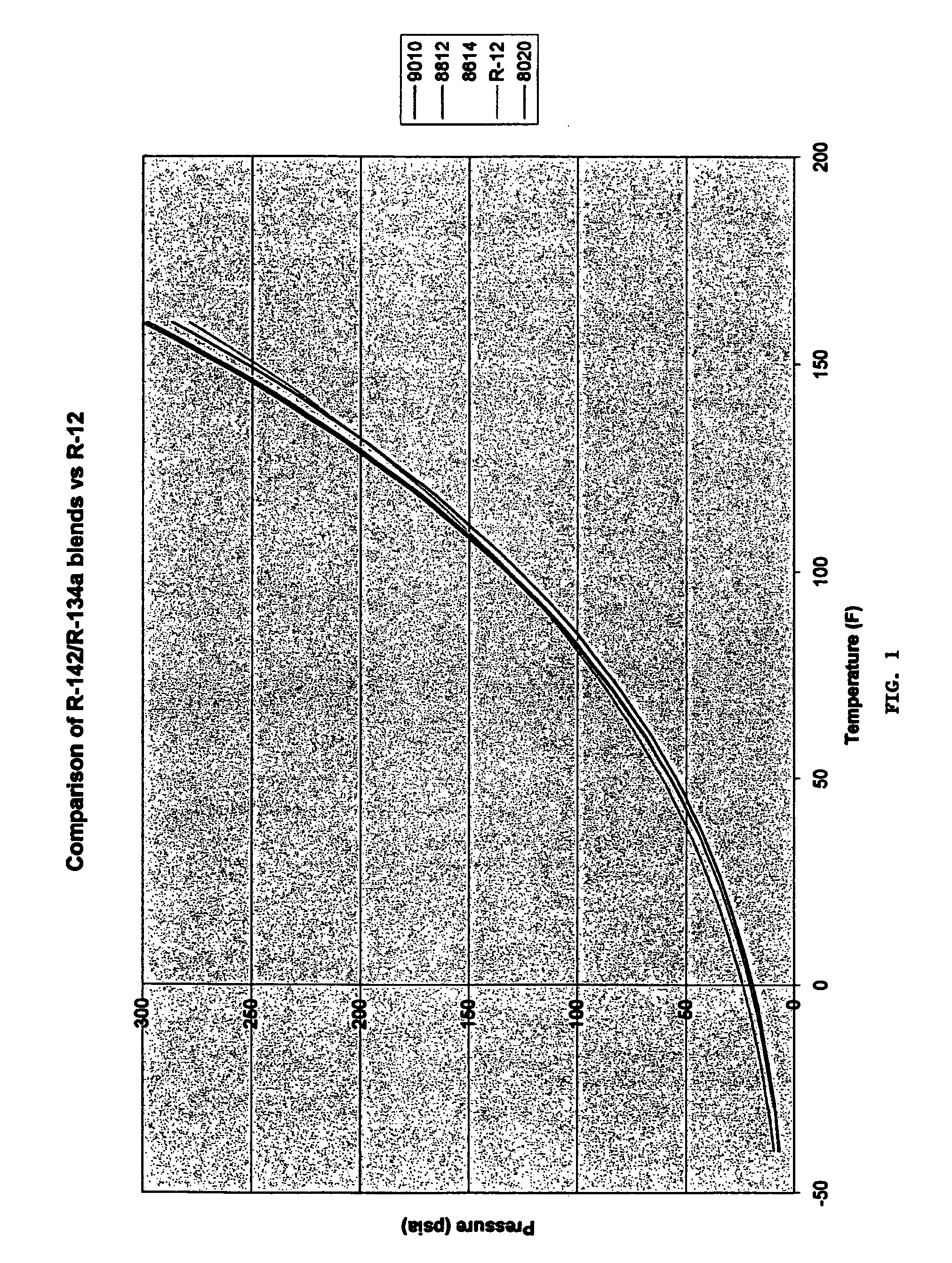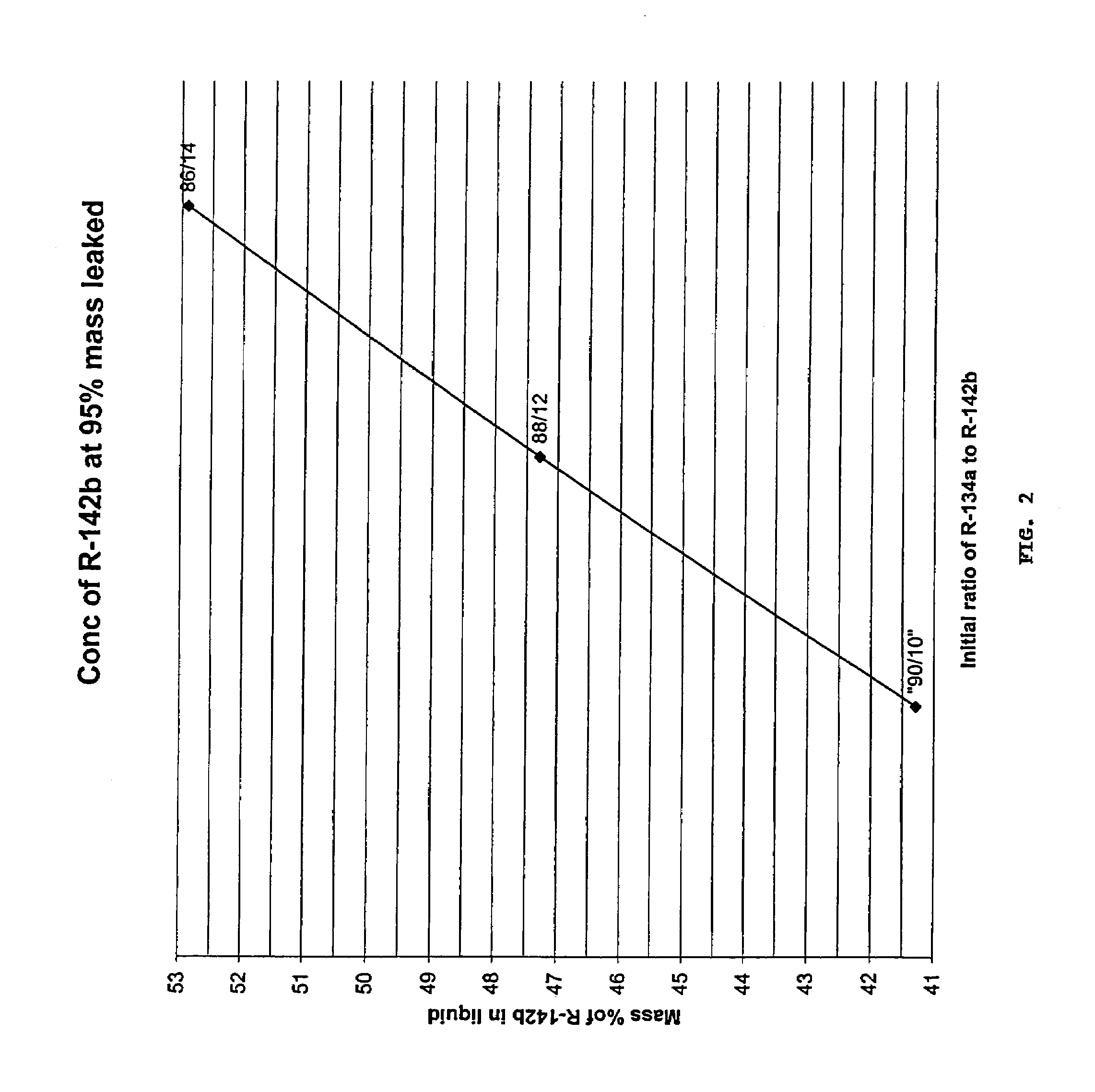Refrigerant with lubricating oil
a technology of refrigerant and lubricating oil, which is applied in the direction of lubricant composition, heat exchange elements, chemical instruments and processes, etc., can solve the problems of system water trapped in the dryer, no teaching or suggestion of lubricant, and illegal intentional mixing of refrigerants
- Summary
- Abstract
- Description
- Claims
- Application Information
AI Technical Summary
Benefits of technology
Problems solved by technology
Method used
Image
Examples
example 1
[0049]1,1,1,2-tetrafluoroethane and dichlorofluoroethane refrigerants are mixed with a suitable lubricant, such as either the Royco 2302 naphthenic lubricant or an alyklbenzene synthetic lubricant (such as L30 or L35 from Shrieve Chemical Company, The Woodlands, Texas, or Zerol 150 from Nu-Calgon Wholesale, Inc., St. Louis, Mo., or AB 150 from Virginia KMP Corporation, Dallas, Tex.) at set ratios such that the temperature-pressure profile of the mixture is compared to that of Refrigerant R-12 (dichlorodifluoromethane), over the normal operating range of air conditioning and refrigeration systems of from about −60° F. to 160° F. The set ratios range from 80% to 90% 1,1,1,2-tetrafluoroethane and 10% to 20% chlorodifluoroethane. A similar temperature-pressure profile was obtained for Refrigerant R-12 (dichlorodifluoromethane). The results were plotted and compared in FIG. 1. FIG. 1 shows that as the amount of tetrafluoroethane increases in the blends, the temperature-pressure profile o...
example 2
[0055]A temperature glide example of a mixture of 12% chlorodifluoroethane and 88% afluoroethane refrigerants was conducted at a temperature of 80° F. The exemplary mixture had a temperature glide of 2.5° F. as compared to 4° F. for R-12. The resulting temperature glide chart is in Table 2 below.
[0056]
TABLE 2TempP BubbleP Dew(° F.)(psia)(psia)−406.9416.641−397.1656.855−387.3897.069−377.6137.283−367.8377.497−358.0617.711−348.2857.925−338.5098.139−328.7338.353−318.9578.567−309.1818.781−299.4609.048−289.7399.315−2710.0189.582−2610.2979.849−2510.57610.116−2410.85510.383−2311.13410.650−2211.41310.917−2111.69211.184−2011.97111.451−1912.31411.779−1812.65712.107−1713.00012.435−1613.34312.763−1513.68613.091−1414.02913.419−1314.37213.747−1214.71514.075−1115.05814.403−1015.40114.731−0915.81715.130−0816.23315.529−0716.64315.928−0617.05916.327−0517.47516.726−0417.89117.125−0318.30717.524−0218.72317.923−0119.13918.3220.019.55518.7211.020.05619.2017.023.06222.0818.023.56322.5619.024.06423.04110.02...
PUM
| Property | Measurement | Unit |
|---|---|---|
| boiling point | aaaaa | aaaaa |
| boiling point | aaaaa | aaaaa |
| boiling point | aaaaa | aaaaa |
Abstract
Description
Claims
Application Information
 Login to View More
Login to View More - R&D
- Intellectual Property
- Life Sciences
- Materials
- Tech Scout
- Unparalleled Data Quality
- Higher Quality Content
- 60% Fewer Hallucinations
Browse by: Latest US Patents, China's latest patents, Technical Efficacy Thesaurus, Application Domain, Technology Topic, Popular Technical Reports.
© 2025 PatSnap. All rights reserved.Legal|Privacy policy|Modern Slavery Act Transparency Statement|Sitemap|About US| Contact US: help@patsnap.com


